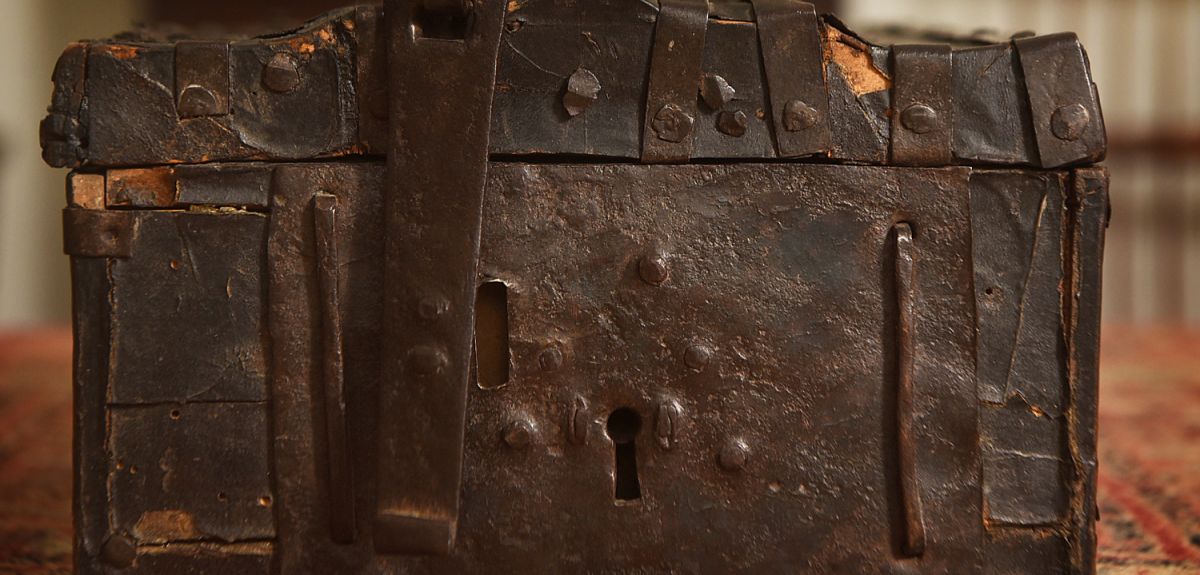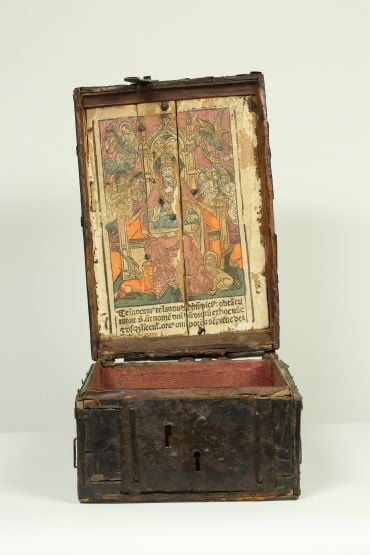
Image credit: Bodleian Libraries and Richard Cave
Bodleian acquires rare medieval book chest, now featuring in new display
A rare 15th-century French Gothic coffer, believed to have been used for housing and transporting religious texts, has been acquired by the University of Oxford’s Bodleian Libraries. Thousands of manuscripts and printed books survive from medieval Europe but just over 100 book coffers are known to be in existence. This book-box forms the centrepiece of a new display at the Bodleian’s Weston Library, titled Thinking Inside the Box: Carrying Books Across Cultures, which opened on 19 January and continues until 17 February 2019.
The coffer is a small wooden chest complete with a vividly coloured woodcut print depicting ‘God the Father in Majesty’. It was acquired from a dealer with support from Art Fund, the Bodleian’s Kenneth Rose Fund and the Friends of the Bodleian.
The Bodleian Libraries hold one of the largest collections of medieval manuscripts and early printed texts in the world, but boxes and other objects for the storing and transporting of books rarely survive. This is the first coffer of its kind to enter the Libraries’ collections. It is hoped that the coffer will help researchers, curators and visitors understand more about how items were stored, transported or used in the very early days of printing in Europe.
This acquisition gives us greater insight into the ‘everyday life’ of books and print culture more broadly. The coffer provides a link between books held at the Bodleian and cultural objects which were once united, but now usually live apart in libraries and museums around the world.
 The coffer features a vivid woodcut print.
The coffer features a vivid woodcut print.Dr Christopher Fletcher, Keeper of Special Collections at the Bodleian Libraries, said: “The Bodleian collects books and manuscripts but also objects which helps us to understand the history and culture of the book – how they were kept, used, moved and understood. The coffer is a remarkable item which is both utilitarian and devotional and preserves an exceptionally rare woodcut in its original context. Among other things, it shows us that our preoccupation with carrying information around with us in mobile devices – including texts and images – is nothing new.”
The majority of surviving book chests date to the 1500s. The Bodleian’s 500-year-old coffer is made of wood covered in leather, reinforced with iron fittings, hinges and a lock. The inside lid contains a fragile image dated to c.1491 and a prayer, in Latin, used as a chant on special feast days. Only four impressions of this woodprint are known to survive, dating from the very early days of printing in Europe.
What the coffer was designed to hold remains a mystery. It could have held a richly illuminated Book of Hours, alongside other Christian devotional books or materials, such as a rosary. The book would have been protected in the chest by a lining of red canvas, which survives still largely intact. Some surviving coffers contain hidden compartments and straps suggesting that they may have held additional relics and were designed for carrying.
Dr Cristina Dondi, Professor of Early European Book Heritage at the University of Oxford and Oakeshott Senior Research Fellow in the Humanities at Lincoln College, said: “Very few original woodblock prints from this period survive and each is rich in meaning, complex and exceedingly rare. So to be able to study one still attached to a physical object of this nature is truly exceptional.”
“This coffer dates to a time when devotional materials were at the crossing between the medieval and the modern period, between art made by hand and by mechanical means. The new arrival will join the right environment to further its investigation and understand how to place it within a European tradition,” said Professor Dondi, who is also the Principal Investigator of the 15cBOOKTRADE, an ERC-funded project which studies the impact of the printing revolution on early modern European society.
The Bodleian Libraries will make the coffer available to researchers; the Libraries already support programmes of scholarship in early printed books through its Centre for the Study of the Book and its Visiting Scholars programme, and funds academics to delve deeper into the Libraries’ unique manuscript holdings and early printed books.
Members of the public can see the coffer at the free Thinking Inside the Box display, which also features about a dozen fascinating boxes, bags and satchels from around the world that have been used to carry books through the ages. Visitors can see such treasures as Qur’anic manuscripts with specially designed satchels, a palm leaf manuscript from West Java inside a beautifully carved, lacquered and painted box, the Kennicott Bible with a lockable wooden carrying case, and a miniature artist’s book which springs from a faux matchbox to reveal an accordion-fold of 13 wood engravings. For more information, including opening times, visit https://www.bodleian.ox.ac.uk/whatson/whats-on/upcoming-events/2019/jan/thinking-inside-the-box.
There will also be a special Thinking Inside the Box activity day on 2 February, offering visitors of all ages the opportunity to meet expert curators, explore the technology behind creating modern boxes for library and museum objects, watch an artist demonstrate the technique of traditional wood engraving, and create their own miniature matchbox book. For more information, visit https://www.bodleian.ox.ac.uk/whatson/whats-on/upcoming-events/2019/feb/thinking-inside-the-box-activity-day
A 3D model and photos of the coffer are available to view on the University of Oxford’s Cabinet website, which uses digitisation to make museum collections more accessible for teaching and research. View the coffer at https://www.cabinet.ox.ac.uk/gothiccoffer. In addition, Cabinet also includes a 3D model and photos of a deed box, which features in the Thinking Inside the Box display. View the deed box at https://www.cabinet.ox.ac.uk/deedbox.